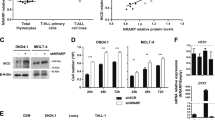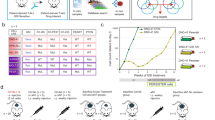Abstract
Activating mutations in NOTCH1 are present in over 50% of human T-cell lymphoblastic leukemia (T-ALL) samples and inhibition of NOTCH1 signaling with γ-secretase inhibitors (GSI) has emerged as a potential therapeutic strategy for the treatment of this disease. Here, we report a new human T-cell lymphoma line CUTLL1, which expresses high levels of activated NOTCH1 and is extremely sensitive to γ-secretase inhibitors treatment. CUTLL1 cells harbor a t(7;9)(q34;q34) translocation which induces the expression of a TCRB-NOTCH1 fusion transcript encoding a membrane-bound truncated form of the NOTCH1 receptor. GSI treatment of CUTLL1 cells blocked NOTCH1 processing and caused rapid clearance of activated intracellular NOTCH1. Loss of NOTCH1 activity induced a gene expression signature characterized by the downregulation of NOTCH1 target genes such as HES1 and NOTCH3. In contrast with most human T-ALL cell lines with activating mutations in NOTCH1, CUTLL1 cells showed a robust cellular phenotype upon GSI treatment characterized by G1 cell cycle arrest and increased apoptosis. These results show that the CUTLL1 cell line has a strong dependence on NOTCH1 signaling for proliferation and survival and supports that T-ALL patients whose tumors harbor t(7;9) should be included in clinical trials testing the therapeutic efficacy NOTCH1 inhibition with GSIs.
This is a preview of subscription content, access via your institution
Access options
Subscribe to this journal
Receive 12 print issues and online access
$259.00 per year
only $21.58 per issue
Buy this article
- Purchase on Springer Link
- Instant access to full article PDF
Prices may be subject to local taxes which are calculated during checkout






Similar content being viewed by others
References
Weng AP, Ferrando AA, Lee W, Morris JPT, Silverman LB, Sanchez-Irizarry C et al. Activating mutations of NOTCH1 in human T cell acute lymphoblastic leukemia. Science 2004; 306: 269–271.
Duncan AW, Rattis FM, DiMascio LN, Congdon KL, Pazianos G, Zhao C et al. Integration of Notch and Wnt signaling in hematopoietic stem cell maintenance. Nat Immunol 2005; 6: 314–322.
Jaleco AC, Neves H, Hooijberg E, Gameiro P, Clode N, Haury M et al. Differential effects of Notch ligands Delta-1 and Jagged-1 in human lymphoid differentiation. J Exp Med 2001; 194: 991–1002.
Pear WS, Radtke F . Notch signaling in lymphopoiesis. Semin Immunol 2003; 15: 69–79.
Pui JC, Allman D, Xu L, DeRocco S, Karnell FG, Bakkour S et al. Notch1 expression in early lymphopoiesis influences B versus T lineage determination. Immunity 1999; 11: 299–308.
Radtke F, Wilson A, Stark G, Bauer M, van Meerwijk J, MacDonald HR et al. Deficient T cell fate specification in mice with an induced inactivation of Notch1. Immunity 1999; 10: 547–558.
Pear WS, Aster JC . T cell acute lymphoblastic leukemia/lymphoma: a human cancer commonly associated with aberrant NOTCH1 signaling. Curr Opin Hematol 2004; 11: 426–433.
Schmitt TM, Ciofani M, Petrie HT, Zuniga-Pflucker JC . Maintenance of T cell specification and differentiation requires recurrent notch receptor-ligand interactions. J Exp Med 2004; 200: 469–479.
Wolfer A, Wilson A, Nemir M, MacDonald HR, Radtke F . Inactivation of Notch1 impairs VDJbeta rearrangement and allows pre-TCR-independent survival of early alpha beta Lineage Thymocytes. Immunity 2002; 16: 869–879.
Washburn T, Schweighoffer E, Gridley T, Chang D, Fowlkes BJ, Cado D et al. Notch activity influences the alphabeta versus gammadelta T cell lineage decision. Cell 1997; 88: 833–843.
Deftos ML, Bevan MJ . Notch signaling in T cell development. Curr Opin Immunol 2000; 12: 166–172.
Fowlkes BJ, Robey EA . A reassessment of the effect of activated Notch1 on CD4 and CD8 T cell development. J Immunol 2002; 169: 1817–1821.
Izon DJ, Punt JA, Xu L, Karnell FG, Allman D, Myung PS et al. Notch1 regulates maturation of CD4+ and CD8+ thymocytes by modulating TCR signal strength. Immunity 2001; 14: 253–264.
Robey E, Chang D, Itano A, Cado D, Alexander H, Lans D et al. An activated form of Notch influences the choice between CD4 and CD8T cell lineages. Cell 1996; 87: 483–492.
Fryer CJ, White JB, Jones KA . Mastermind recruits CycC:CDK8 to phosphorylate the Notch ICD and coordinate activation with turnover. Mol Cell 2004; 16: 509–520.
Ellisen LW, Bird J, West DC, Soreng AL, Reynolds TC, Smith SD et al. TAN-1, the human homolog of the Drosophila notch gene, is broken by chromosomal translocations in T lymphoblastic neoplasms. Cell 1991; 66: 649–661.
O'Neil J, Calvo J, McKenna K, Krishnamoorthy V, Aster JC, Bassing CH et al. Activating Notch1 mutations in mouse models of T-ALL. Blood 2006; 107: 781–785.
Look AT, Hayes FA, Nitschke R, McWilliams NB, Green AA . Cellular DNA content as a predictor of response to chemotherapy in infants with unresectable neuroblastoma. N Engl J Med 1984; 311: 231–235.
Lin MH, Leimeister C, Gessler M, Kopan R . Activation of the Notch pathway in the hair cortex leads to aberrant differentiation of the adjacent hair-shaft layers. Development 2000; 127: 2421–2432.
Ferrando AA, Look AT . Clinical implications of recurring chromosomal and associated molecular abnormalities in acute lymphoblastic leukemia. Semin Hematol 2000; 37: 381–395.
Pui CH, Relling MV, Downing JR . Acute lymphoblastic leukemia. N Engl J Med 2004; 350: 1535–1548.
Barrett AJ, Horowitz MM, Pollock BH, Zhang MJ, Bortin MM, Buchanan GR et al. Bone marrow transplants from HLA-identical siblings as compared with chemotherapy for children with acute lymphoblastic leukemia in a second remission. N Engl J Med 1994; 331: 1253–1258.
Biggs JC, Horowitz MM, Gale RP, Ash RC, Atkinson K, Helbig W et al. Bone marrow transplants may cure patients with acute leukemia never achieving remission with chemotherapy. Blood 1992; 80: 1090–1093.
Dopfer R, Henze G, Bender-Gotze C, Ebell W, Ehninger G, Friedrich W et al. Allogeneic bone marrow transplantation for childhood acute lymphoblastic leukemia in second remission after intensive primary and relapse therapy according to the BFM- and CoALL-protocols: results of the German Cooperative Study. Blood 1991; 78: 2780–2784.
Forman SJ, Schmidt GM, Nademanee AP, Amylon MD, Chao NJ, Fahey JL et al. Allogeneic bone marrow transplantation as therapy for primary induction failure for patients with acute leukemia. J Clin Oncol 1991; 9: 1570–1574.
Schroeder H, Gustafsson G, Saarinen-Pihkala UM, Glomstein A, Jonmundsson G, Nysom K et al. Allogeneic bone marrow transplantation in second remission of childhood acute lymphoblastic leukemia: a population-based case control study from the Nordic countries. Bone Marrow Transplant 1999; 23: 555–560.
Acknowledgements
We thank Vladan Miljkovic in the ICG Microarray Facility for assistance with microarray experiments, the Cytogenetics Core Laboratory and Dr Subhadra Nandula for help with karyotype and FISH analysis.
Author information
Authors and Affiliations
Corresponding author
Additional information
Supplementary Information accompanies the paper on the Leukemia website (http://www.nature.com/leu)
Supplementary information
Rights and permissions
About this article
Cite this article
Palomero, T., Barnes, K., Real, P. et al. CUTLL1, a novel human T-cell lymphoma cell line with t(7;9) rearrangement, aberrant NOTCH1 activation and high sensitivity to γ-secretase inhibitors. Leukemia 20, 1279–1287 (2006). https://doi.org/10.1038/sj.leu.2404258
Received:
Accepted:
Published:
Issue Date:
DOI: https://doi.org/10.1038/sj.leu.2404258
Keywords
This article is cited by
-
The Notch1 signaling pathway directly modulates the human RANKL-induced osteoclastogenesis
Scientific Reports (2023)
-
Cell-type-specific prediction of 3D chromatin organization enables high-throughput in silico genetic screening
Nature Biotechnology (2023)
-
Notch1 and Notch4 core binding domain peptibodies exhibit distinct ligand-binding and anti-angiogenic properties
Angiogenesis (2023)
-
Extracellular vesicle microRNAs contribute to Notch signaling pathway in T-cell acute lymphoblastic leukemia
Molecular Cancer (2022)
-
Cross-talk between GLI transcription factors and FOXC1 promotes T-cell acute lymphoblastic leukemia dissemination
Leukemia (2021)



